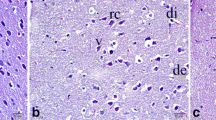Abstract
This study aimed to investigate the effects of catalpol on ATPase and amino acids in gerbils following cerebral ischemia/reperfusion (CI/R) injury. Gerbil model of CI/R was prepared by bilateral common carotid occlusion for 10 min followed by 6 h of reperfusion. Catalpol (5, 10 or 20 mg/kg per day) was injected intraperitoneally for 3 days before the carotid occlusion. Stroke index was measured during the reperfusion. ATPase activity, glutamate (Glu) and aspirate contents in brain tissue homogenate were examined. The results showed that catalpol significantly improved the stroke index compared with sham group (P < 0.05 or P < 0.01). Catalpol markedly increased the activities of Na+–K+-ATPase and Ca2+-ATPase (P < 0.05 or P < 0.01), and significantly decreased the content of Glu in brain tissue (P < 0.05 or P < 0.01). These data suggest that the efficacy of catalpol pretreatment on CI/R injury is associated with the enhancement of ATPase activity and the inhibition of excitatory amino acid toxicity.


Similar content being viewed by others
References
Winquist RJ, Kerr S (1997) Cerebral ischemia–reperfusion injury and adhesion. Neurology 49:S23–S26
Siesjö BK, Zhao Q, Pahlmark K, Siesjö P, Katsura K, Folbergrová J (1995) Glutamate, calcium, and free radicals as mediators of ischemic brain damage. Ann Thorac Surg 59:1316–1320
Chi OZ, Hunter C, Liu X, Weiss HR (2009) Effects of exogenous excitatory amino acid neurotransmitters on blood–brain barrier disruption in focal cerebral ischemia. Neurochem Res 34:1249–1254
Koch HJ, Uyanik G, Bogdahn U, Ickenstein GW (2006) Relation between laterality and immune response after acute cerebral ischemia. Neuroimmunomodulation 13:8–12
Yu H, Oh-Hashi K, Tanaka T, Sai A, Inoue M, Hirata Y, Kiuchi K (2006) Rehmannia glutinosa induces glial cell line-derived neurotrophic factor gene expression in astroglial cells via cPKC and ERK1/2 pathways independently. Pharmacol Res 54:39–45
Zhang X, Zhang A, Jiang B, Bao Y, Wang J, An L (2008) Further pharmacological evidence of the neuroprotective effect of catalpol from Rehmannia glutinosa. Phytomedicine 15:484–490
Li DQ, Bao YM, Zhao JJ, Liu CP, Liu Y, An LJ (2004) Neuroprotective properties of catalpol in transient global cerebral ischemia in gerbils: dose–response, therapeutic time-window and long-term efficacy. Brain Res 1029:179–185
Li DQ, Bao YM, Li Y, Wang CF, Liu Y, An LJ (2006) Catalpol modulates the expressions of Bcl-2 and Bax and attenuates apoptosis in gerbils after ischemic injury. Brain Res 1115:179–185
Li Y, Bao Y, Jiang B, Wang Z, Liu Y, Zhang C, An L (2008) Catalpol protects primary cultured astrocytes from in vitro ischemia-induced damage. Int J Dev Neurosci 26:309–317
Li Y, Li DQ, Bao YM, An LJ (2005) Study on protective effect of catalpol against injury of ischemia–reperfusion. China J Modern Med 15:1454–1456 (Chinese)
Chen Q, Zeng YM, Xu PC, Fan JW (2000) Influence of batroxobin on cerebral ischemia–reperfusion injury in gerbils. Acta Pharmacol Sin 21:161–164
Ohno K, Ito U, Inaba Y (1984) Regional cerebral blood flow and stroke index after left carotid artery ligation in the conscious gerbil. Brain Res 297:151–157
Teerlink T, Nijveldt RJ, de Jong S, van Leeuwen PA (2002) Determination of arginine, asymmetric dimethylarginine, and symmetric dimethylarginine in human plasma and other biological samples by high-performance liquid chromatography. Anal Biochem 303:131–137
Bahjat FR, Gesuete R, Stenzel-Poore MP (2013) Steps to translate preconditioning from basic research to the clinic. Transl Stroke Res 4:89–103
Gupta YK, Briyal S, Gulati A (2010) Therapeutic potential of herbal drugs in cerebral ischemia. Indian J Physiol Pharmacol 54:99–122
Jorgensen PL, Pedersen PA (2001) Structure–function relationships of Na+, K+, ATP, or Mg2+ binding and energy transduction in Na, K-ATPase. Biochim Biophys Acta 1505:57–74
Jung YW, Choi IJ, Kwon TH (2007) Altered expression of sodium transporters in ischemic penumbra after focal cerebral ischemia in rats. Neurosci Res 59:152–159
Dávalos A, Shuaib A, Wahlgren NG (2000) Neurotransmitters and pathophysiology of stroke: evidence for the release of glutamate and other transmitters/mediators in animals and humans. J Stroke Cerebrovasc Dis 9:2–8
Koizumi H, Fujisawa H, Suehiro E, Shirao S, Suzuki M (2011) Neuroprotective effects of ebselen following forebrain ischemia: involvement of glutamate and nitric oxide. Neurol Med Chir 51:337–343
Bie X, Chen Y, Han J, Dai H, Wan H, Zhao T (2007) Effects of gastrodin on amino acids after cerebral ischemia–reperfusion injury in rat striatum. Asia Pac J Clin Nutr 16(Suppl 1):305–308
Katayama Y, Becker DP, Tamura T, Hovda DA (1990) Massive increases in extracellular potassium and the indiscriminate release of glutamate following concussive brain injury. J Neurosurg 73:889–900
Chao XD, Fei F, Fei Z (2010) The role of excitatory amino acid transporters in cerebral ischemia. Neurochem Res 35:1224–1230
Kuang P, Xiang J (1994) Effect of radix salviae miltiorrhizae on EAA and IAA during cerebral ischemia in gerbils: a microdialysis study. J Tradit Chin Med 14:45–50
Acknowledgments
This work was supported by the Foundation of He’nan Educational Committee (14A360010).
Author information
Authors and Affiliations
Corresponding author
Rights and permissions
About this article
Cite this article
Liu, Yr., Lei, Ry., Wang, Ce. et al. Effects of catalpol on ATPase and amino acids in gerbils with cerebral ischemia/reperfusion injury. Neurol Sci 35, 1229–1233 (2014). https://doi.org/10.1007/s10072-014-1687-7
Received:
Accepted:
Published:
Issue Date:
DOI: https://doi.org/10.1007/s10072-014-1687-7




